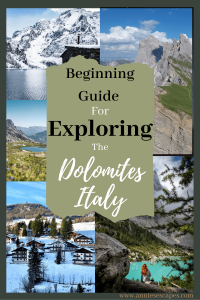
Le Dolomiti aren’t generally top of mind for Americans planning an Italian adventure but they should definitely be added to the list. Located along the Italian-Austrian border, just a few hours north of Venice, the Dolomites offer a breath of fresh air and scenery that will leave you speechless. Jagged pale mountains tower over green rolling hills, towns and villages mix Austrian Chalets with sunny Italian piazzas, medieval churches, and modern world-renowned restaurants. Reliable snowfall creates a winter wonderland of luxury ski resorts and breathtaking snowshoeing paths, while the lush alpine meadows burst into bloom along the hundreds of hiking trails and glacial lakes in the summer. These mountains are a nature lover’s paradise, but you don’t have to be an expert hiker or mountaineer to enjoy the trails, which range from leisurely walks to rock climbing. The Dolomites are a great travel alternative to the Swiss Alps and the perfect starting or ending to your adventure around “The Boot.”
The Basics
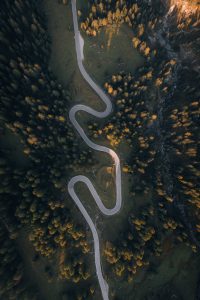
Getting Oriented: If you’re not familiar with exactly where the Dolomites are, that’s okay. You’re not alone. Here’s a helpful map to put the general location in perspective.
Getting Around: The closest airports available are either Venice or Innsbruck and from there you’ll need to take a bus, train, or car into the mountains. Towns both large and small are connected by a network of bus and rail lines, so getting around without a car isn’t impossible. However, if you want to be on your own schedule and arrive early at the more popular sights, we recommend renting a car. The famous Grande Strada Delle Dolomiti cuts through three alpine passes and is one of the most beautiful scenic roads in Europe. With lots of twists and turns without being too hair-raising, driving this road is reason enough to rent a car — just make sure you get an International Driver’s Permit before you arrive!
[Photo Credit: Luke Stackpoole via Unsplash]
Weather- the Dolomites are characterized by short summers and snowy winters. Though both seasons enjoy brilliant sunshine since the Dolomites receive more sun than any other region of the Alps. There are two peak tourist seasons: the height of summer and the depth of winter. In the in-between seasons, you’ll find very few crowds but unpredictable weather, and most businesses and mountain huts closed. Summer Season begins in mid-June and lasts through August for warm sunny days. For all things snowy, the winter season lasts from December until the last snow in early April.
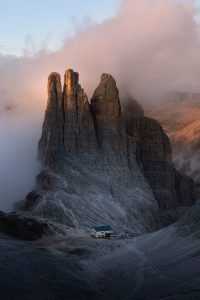
Rifugio – in addition to the range of wellness spas, hotels, chalets, and alpine cabins, the Dolomites give you the option of staying in a rifugio. Meaning refuge, these small inns are dotted along the trails in the heart of the mountains. When hiking from peak to peak you can stop for a delicious warm meal, a hot shower, and a bed for the night. You’re always welcome to stop in for a bite, but beds will have to be reserved well in advance. Rifugios are only open during the peak seasons and range from a dorm bed to romantic private rooms. Waking up to see the sunrise while ensconced in the mountain peaks makes staying at least one night in a rifugio a must-do when hiking in the Dolomites.
[Photo Credit:Ruud Luijten via Unsplash]
Multiple Languages – due to its diverse history of cultures and borders, the Dolomites have four official languages: Italian, German, Ladin, and Friulan. German and Italian are spoken equally depending on the town and the person. In this case, multiple languages mean at least two names for each place! The German and the Italian names often don’t resemble each other in the slightest. While the buses and s,.[igns will have both the German and Italian versions when you ask the locals you may only get one or the other. We recommend noting down both names to help minimize your confusion.
Where to Stay
With 26 mountain ranges stretching across five provinces, the Dolomites cover a lot of ground. To make sure you don’t spend more time driving than experiencing, we recommend selecting only 2-3 areas to explore during your trip. The most popular regions in the Dolomites can be broken up into about 5 slightly overlapping areas, each with diverse highlights but all with stunning beauty and excellent outdoor activities.
Alta Pusteria/ Hochpusterta
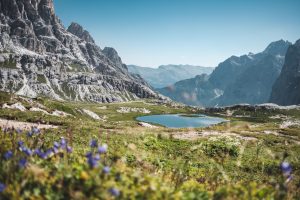
In the north-eastern corner, bordering Austria is the very popular area of Alta Pusteria. Along with the charming romantic towns and impressive mountain views, you’ll find a focus on wellness, gastronomy, and some of the most Instagram-famous sights. Alta Pusteria is perfect for tiny churches, extensive bike paths, exploring castles, enjoying lakes, and taking a restorative bath in the sulfurous waters.
[Photo Credit: Jonas Verstuyft via Unsplash]
Top Sites:
Lago di Braies/Pragser Wildsee– the most famous and most beautiful lake in the Dolomites – enjoy the turquoise water by taking the 3.5km easy walking circuit around it, hire a boat to explore from its center or brave a swim in the glacial waters.
Tre Cime/Drei Zinnen– the poster picture for the Dolomites, these three tall spires have created their own holiday region and national park. You could spend days hiking the trails in and around them, though their main circuit is a 3hr 10.5km trail. Head counterclockwise on the circuit for the best views from within or get an amazing view of the peaks themselves from the steep trail in Val Fiscalina to Rifugio Locatelli.
Towns to Stay in:
Dobbiaco/Toblach – the largest and oldest town in the region. This charming village is the closest hub to Lago di Braies. Austrian cottages and luxury food await your stay.
San Candido/Innichen– a delightfully small hamlet close to the Austrian border but still with an Italian piazza in its center. It is often called The Gem of Val Pusteria.
[Photo Credit: Jeison Higuita via Unsplash]
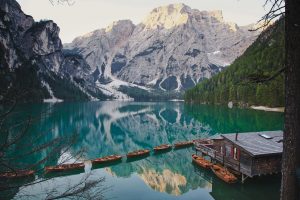
Belluno/Belum
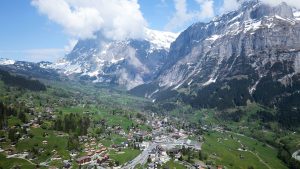
Often considered the gateway to the Dolomites, Belluno is a perfect base for exploring the eastern range. Eighty percent of the mountains are in the Belluno province so the sites to see are extensive. Glaciers, waterfalls, forests, and shopping, Belluno offers a lot of options, making it the perfect spot for those who want to try a bit of everything.
[Photo Credit: Julian Villella via Unsplash]
Top Sights
Rifugio Nuvolau– The oldest rifugio in the Dolomites and one of the best balcony views of the mountains.
Lago di Sorapis/Sorapissee– the slightly hidden lake is a two-hour hike from Cortina but worth the otherworldly views.
Lago Misurina/Misurinasee– clear water reflects the contours of the craggy mountains in this Pearl of the Dolomites. Easily reached from Alta Pusteria, this lake’s special microclimate makes it a center for respiratory health.
Val di Zoldo– a small alpine valley that is the heart of the mountaineers’ villages. This hidden gem is not very busy, so it feels very authentic and genuine. From here you can take the trail to Lago Coldai for a swim.
Monte Cristallo/Hohe Schneide– in the center of the Dolomites, this mountain features four peaks that can be reached by cable car, mountaineering, or skiing.
Towns to Stay In:
Cortina d’Ampezzo– the most famous town around, often called the Queen of the Dolomites. Cortina is the jet-set, trendy and worldly fashionista town nestled in mountainous craggy spires. Not only can you easily get to Tre Cime and Lago di Braies from northerly Cortina, but you can also access a huge number of amazing peaks. But Cortina offers more than just alpine lakes and mountain hikes. Enjoy shopping, gastronomy, and entertainment of all kinds. For those who want a rounded luxury Dolomites experience, this is the place to start.
[Photo Credit:Piotr Guzik via Unsplash]
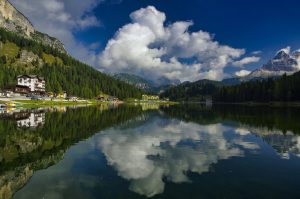
Val Gardena/Gröden
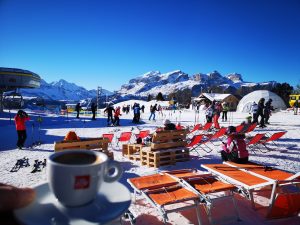
This is the perfect place for those who want to leave their own transport behind and explore as much as they can from one spot. The beautiful Val Gardena boasts a colorful Ladin culture making it a truly unique experience. This culture-rich valley enjoys a slightly longer summer than other areas- often staying open until mid-October. It also features the most famous ski slopes – Sella Ronda. A network of cable cars and ski lifts connect 300 slopes, meaning you can ski all day without repeating a run.
[Photo Credit: Vlado Sestan via Unsplash]
Top Sites:
Seceda Ridgeline– a jaw-dropping photo opportunity, the ridge is a two-hour hike from the gondola or a 5hr hike from the bottom.
Passo Pordoi– the highest surfaced road through a pass- you can take a cable car to the top and find yourself between the Sella and Marmolada peaks.
Monte Pic/ Pitschberg– not as well known, but you will be rewarded with stunning 360 views of the more famous peaks and you won’t have to share the view with anyone else.
Towns to Stay In:
Ortisei/ St Ulrich– the busiest town in Val Gardena because it’s the perfect home base. With several different chairlifts to the top peaks located in the center of town, you don’t need to worry about driving around to reach the amazing views.
Santa Cristina/St Christina– a tiny town located near Ortisei which gives you access to many of the lesser-known trails with fewer people.
[Photo Credit: Giorgi Shakarashvili via Unsplash]
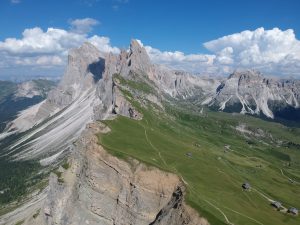
Alta Badia/Hochabtai
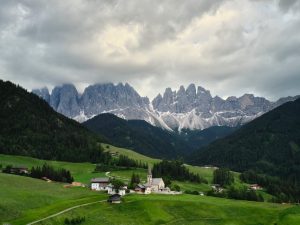
If you only have a short stay in the Dolomites then Alta Badia is the perfect place to spend it. This area features magical fairytale-like valleys, romantic locales, superb food, and extreme sports. Closely connected with Val Gardena, you’ll find some of the Sella Ronda slopes and the unique Ladin culture here as well. Enjoy the storybook landscapes, wellness facilities, and quiet alpine luxury.
[Photo Credit:Massimiliano Coradini via Unsplash]
Top Sites:
Piz Boè– the highest peak of the Sella massif- this can be a challenging climb but the on-top-of-the-world feeling is worth it.
Sasso di Santa Croce/ Ciaval– a breathtaking hike considered one of the most beautiful in the area. With a huge abundance of flora and fauna and mind-boggling views over the lush green valley.
Cascate del Pisciadù– a picturesque hike through wildflower meadows lead to this thin 150m waterfall. This short hike is about an hour each way and can be done at a leisurely pace.
Towns to Stay In:
Corvara/Kurfar is located in the very center. It features many gondolas up to the peaks and is close enough to walk to the nearby villages. You can also enjoy any of the Michelin Star restaurants or play a round of golf at the club.
San Vigilio di Marebbe/ Vigil in Enneberg– a gateway to the Fanes-Sennes natural park this tiny hamlet emphasizes the romantic contrast between the wild and tame landscapes.
Alpe di Siusi/Seiser Alm
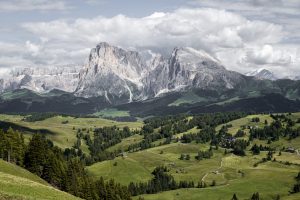
The largest alpine meadow in Europe, with green rolling hills, wooden cabins, and not a car in sight. You can explore the meadows and pastures on horseback, between the scattered farms, or even go bathing in Lake Fie. Gentle soft green meadows and legends of witches and elves make this a delightful spot, especially for families.
[Photo Credit: Pietro de Grandi via Unsplash]
Towns to Stay In:
Castelrotto/Kastelruth– the largest village at the foot of the region. A resort town that features a family-friendly ski park in the winter and a crisscrossing series of trailheads in the summer.
Tires/ Tiers– a holiday village that is the definition of ensconcing yourself in nature. This tiny hamlet is best explored in summer with the many trails and climbing routes.
Bolzano/Bozen– though not strictly in the area, Alpe di Siusi can be easily reached from the large city of Bolzano. This is truly a bustling city with castles, museums, and the opportunity to see the famous Iceman.
[Photo Credit:Lukas Leitner via Unsplash]
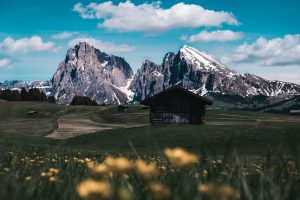
The Dolomites offer so many options and so much to explore it’s definitely an Italian destination you will want to visit again and again. If you feel inspired to plan a mountain adventure and need help choosing the best itinerary – let us know!
